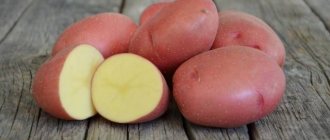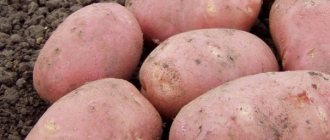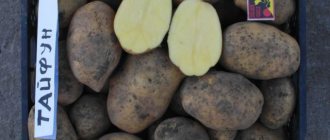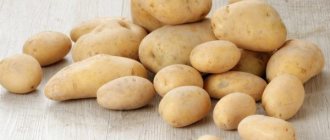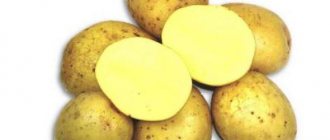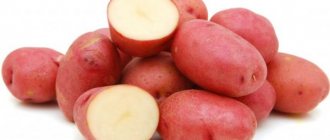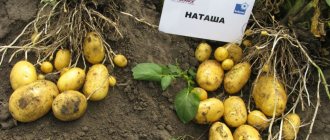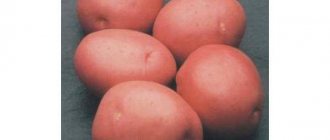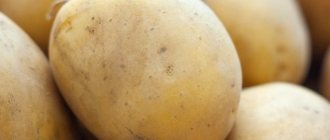Potatoes have become firmly established in our culinary traditions, so it is not surprising that most gardeners plant and harvest this versatile vegetable every year. Moreover, today selection forces are constantly offering new varieties that make it possible to obtain large yields with minimal effort. Gala potatoes are one of the latest developments of the German concern Norika, which gives excellent results in central Russia (the variety is recommended for cultivation in the North-Western and Volga-Vyatka regions), retains high quality during storage and has an excellent taste.
Advantages and disadvantages
Today, Gala potatoes are one of the most positively proven varieties. We list the main advantages:
- a mid-early variety, which allows it to be cultivated in any climatic conditions, with the exception of the tundra,
- has friendly entrances,
- resistant to low temperatures,
- not susceptible to diseases such as tuber blight, scab, glandular spot
- resistant to golden and pale nematodes,
- immune to potato cancer,
- undemanding to soil types,
- high number of tubers under the plant, according to reviews – up to 25 pcs.,
- has smooth, even fruits of medium size,
- keeps well until spring
- high taste qualities,
- high content of starch and carotene,
- suitable as a dietary variety,
- Doesn't get soggy when cooking.
But there are no plants without shortcomings, so the Gala variety has average resistance to the Colorado potato beetle, late blight of tops and leaf curl virus.
Description
"Gala" refers to the table varieties of medium-early ripening. The growing season before the onset of technical ripeness is 70-80 days. Young tubers reach a size sufficient for consumption by the 40th day after germination.
The plant is of medium height, semi-erect, the flower corollas are white in color.
Potato bushes are medium-sized, semi-erect. Stems are medium thick; the leaves are large, green, matte, with moderate wavy edges. The inflorescences are small, with a small number of white flowers. Anthocyanin coloring on the inside of the flower, stems and leaf veins is absent or very weak.
Anthocyanins are plant pigments that color the fruits and seeds of plants, their generative (flowers, pollen) and vegetative (stems, leaves, roots) organs in purple, blue, dark blue and violet colors.
Plants demonstrate friendly and uniform germination. The tops grow moderately, but close in rows quite quickly.
Tubers
The tuber is of medium size, at the stage of technical ripeness it weighs about 70-120 g. The shape is elongated or round-oval, the ratio of length to diameter (shape index): 1/1.1-1.29. The peel is yellow, quite dense, with a smooth or slightly flaky (smooth mesh) surface. The eyes are small in number, small, and lie to a depth of 1-1.3 mm. The light sprout is distinguished by its ovoid shape and red-violet color at the base, with weak or medium density of pubescence.
Potato tubers "Gala" (pictured) are round-oval in shape, with yellow skin and small eyes
Due to their small eyes, even shape and low susceptibility to black spot, the tubers are ideal for mechanical peeling. The pulp is dark yellow with a slight tendency to darken when raw. Potatoes “Gala” have a tasting rating of 5 points based on their taste characteristics. After cooking and other types of heat treatment, the tubers practically do not change color and do not crumble, maintaining a predominantly solid texture (A/B boilability type).
The flattened shape of the tubers, small eyes, and low susceptibility to black spot ensure ease of manual and mechanical peeling
According to the classification accepted in Western European countries, table types of potatoes are divided into 4 groups and labeled with the corresponding Latin letters from A to D. Depending on their use in cooking, potatoes are divided into 4 types: • A – salad-type varieties with dense, non-cooked pulp; • B – universal, slightly mealy, with dense, slightly boiling pulp; • C – medium mealy, with soft, highly boiled pulp; • D – completely boiled, intended only for making purees.
The nutritional value
The yellow color of the tubers indicates a large amount of carotene (provitamin A). The average content of nutrients in fruits is as follows:
| Nutrients and beneficial substances | Content |
| Starch | 10,2-13,2% |
| Squirrels | 1,8% |
| Reducing sugars | 0,31% |
| Vitamin C | 22.3 mg% |
After cooking, the tubers practically do not change color and do not crumble, maintaining a dense, delicate texture.
Due to their high taste and preservation of the fiber structure, the purpose of tubers is universal: they are used for all types of processing. And due to the small amount of starch and the presence of vitamins, Gala potatoes are even recommended as a dietary food product.
Productivity
The variety is considered high-yielding, distinguished by a large number of tubers in one nest (10-16 pieces, and according to some sources up to 25) and their even size.
The Gala potato, according to reviews from vegetable growers, is capable of forming up to 25 tubers in one nest; on average, 10-16 tubers are obtained from one plant, having uniform sizes and an attractive presentation
The marketable yield of young potatoes “Gala” on the 40th day after entry is about 150-170 c/ha, and at the stage of technical ripeness at the end of the growing season it is:
- in Russia the average is 220-263 c/ha (at the level of the Nevsky variety standard), the maximum is 390 c/ha (in the Vologda region);
- in Belarus, the average is 337 c/ha, the maximum is 568 c/ha (obtained in 2008 at the Molodechno Variety Testing Station).
The variety provides a commercial output of 71-94% of the total harvest. The shelf life is high - 89-96%, which ensures reliable transportation and long storage without loss of external and taste qualities.
Sustainability
The variety is resistant to mechanical damage to tubers, Colorado potato beetle invasions and a whole range of viral, fungal and bacterial diseases:
| Degree of stability | Diseases |
| High | Golden and pale nematodes (Ro1, Ro4); rhizoctoniasis; potato canker (D1); virus Y; late blight of tubers; blackleg; glandular spotting; common scab |
| Average | Late blight of tops; leaf roll virus |
This variety is resistant to Colorado potato beetle attacks (but preventive measures still need to be taken)
Features of cultivation
In order for the marketability and taste of potatoes to be at a high level, experienced gardeners advise not to plant the remains of their harvests from year to year, but to purchase planting material from reputable, trusted manufacturers, who carefully sort, disinfect and control it.
Packages with planting material for potatoes of the Gala variety from various manufacturers
If you prefer to use your own potatoes for planting, then select only healthy and whole small-sized tubers. Better germination and an additional antibacterial effect can be achieved by warming them up before planting for 2-3 days in the sun. It is advisable to treat seed potatoes with special compounds against pests and growth stimulants.
Potato "Gala" is undemanding to soil composition and responds well to fertilizing and abundant watering.
It is recommended to plant seed potatoes at the end of April, deepening them into the soil by 10-15 cm and leaving a distance of 70-75 cm between the holes. To increase productivity, young shoots are covered with soil, and then the stems are hilled up during the growth process, adding fertilizers. Plants require regular watering and preventive treatments against pests and diseases with organic or chemical preparations. An important agrotechnical practice is considered to be pruning the tops 10-12 days before harvesting, which can significantly increase the subsequent storage of tubers.
In order for the bushes to form a powerful root system, it is recommended to cover the young shoots with soil.
According to reviews from numerous gardeners, the Gala potato variety is quite easy to care for, provides high yields in different soil and climatic conditions, and is distinguished by early ripening and shelf life. It is called one of the most successful varieties, optimally suited for cultivation in the middle zone.
Agricultural technology
Potatoes are grown in compliance with all cultivation requirements. Before planting, small, egg-sized tubers weighing 20-30 grams are selected. Pay attention to the number of eyes on the tuber - there should be more than two and they should not be damaged. Planting material cannot have mechanical damage or traces of disease.
To protect against diseases and improve seedlings, it is recommended to warm the selected tubers in the sun 2-3 days before planting, but not to dry them out. After a sunbath, the potatoes should be placed in a warm room and covered with a thick, slightly damp cloth for active root formation. Experienced vegetable growers also recommend spraying the tubers with preparations that stimulate the formation of the root system.
Gala potatoes are planted to a depth of up to 15 cm (half a shovel), planting in ridges or furrows is acceptable. The recommended distance between holes is 60-75 cm.
This potato variety responds positively to hilling and loosening. It is recommended to carry out two high hillings per season, with a maximum height of cover for the stems. The first of them is carried out when the above-ground part of the plant reaches a height of 20-30 cm. The second - 3 weeks after the first.
Advantages and disadvantages
Before planting any crop on your own plot, it is worth studying the advantages and disadvantages. Gala has the following pros and cons:
Advantages
- The harvest ripens under any conditions; planting dates are not important.
- Potatoes can be harvested very early.
- The crop stores well, withstands transportation, and retains its transport characteristics for a long time.
- Good yield indicators: up to 25 tubers per bush.
- Potatoes are ideal for people who adhere to the principles of a healthy diet due to their low starch content.
- The taste of root vegetables is very pleasant; they do not fall apart or darken during heat treatment.
- Gala is unpretentious in terms of care.
Flaws
- Susceptibility to rhizoctonia.
- Depends on soil moisture.
Planting dates and vegetation characteristics
In the southern regions of Russia, Ukraine and Belarus, Gala potatoes are recommended to be planted at the end of April. The variety is quite cold-resistant and is distinguished by vigorous shoots even under unfavorable climatic conditions. In the northern regions and the Siberian district, planting of potatoes of this variety is shifted by 2-3 weeks and is carried out from May 10 to May 15.
The Gala variety is tolerant of excess moisture, but does not tolerate drought well and requires regular watering.
The first harvest of young Gala potatoes can be harvested already 60 days after planting, or 45-50 after planting. Full technical maturity of this variety occurs 80 days after germination. After this, the potatoes can be dug up and stored for long-term storage.
Main characteristics
Gala is a medium-early ripening table variety. Bushes of medium height, semi-erect. The stems are of moderate thickness. The foliage is large, green, matte. There is a slight waviness along the edges. The culture produces small inflorescences and few flowers. The tops do not grow too much, but they close in rows at high speed.
Potatoes easily adapt to different soil compositions and climatic conditions. Gala can produce a harvest in almost any region of Russia. The variety, moreover, is not afraid of two types of nematodes, which increases its popularity among gardeners.
Soils and fertilizing
Gala potatoes are not picky about the type of soil; it can be cultivated even on sandy and sandy loam soils, but attention should be paid to the balance of nutrients and fertilizers. It is recommended to apply fertilizers to the hole during planting and to frequently water the entrances during the planting of root crops. The second feeding should be carried out 40-45 days after planting along with watering.
You can use organic or mineral fertilizers for fertilizing. If you use manure, then only rotted material should be added to the hole in a volume of 200-250 g per bush. When fertilizing with chicken manure, it should be pre-soaked in the proportions of 1 part manure to 15 parts water. About 1 liter of solution is poured under the tuber.
This variety responds positively to the application of mineral fertilizer complexes based on nitrogen compounds during the period of plant development and based on sulfates during the period of formation and ripening of tubers.
The second feeding of the Gala variety is carried out after the first hilling, but not earlier than 40 days after planting. At this time, potatoes are preparing for flowering and laying young tubers, which means they need potassium and phosphorus. Fertilizers of potassium sulfate, superphosphate, as well as an infusion of wood ash or ammonium nitrate are used as top dressing.
Attention! Hilling potatoes should not be carried out in dry and hot weather. Dry soil in the process injures the root system of the plant and the developing fruits, which can lead to defects in the appearance of the potato, as well as to the death of the bush.
It is during this period that preventive measures against fungal diseases of potatoes should be taken, which will improve the quality of storage of ripened tubers and will preserve the health of the soil.
How to properly care for the variety
When caring for potatoes, you should take into account the peculiarities of watering, applying fertilizers, and know when to weed and hill up the bushes.
Features of watering
One of the main conditions for growing Galla potatoes is watering during dry periods. The soil must not be allowed to dry out and crack. This procedure is carried out in the morning or evening, when there is no scorching sun. It is best to arrange drip irrigation. If this is not possible, then it is worth watering at least 3 times a season:
- the first time - during germination (in dry weather);
- the second time - during budding (in dry or cloudy weather);
- the third time - after the plants bloom (in dry weather).
10-15 liters are poured under each bush. For greater efficiency, use watering cans with nozzles.
Feeding and fertilizing
Potatoes are fertilized during the process of loosening or hilling. For feeding use:
- chicken manure diluted with water (1:10 ratio);
- urea (1 tablespoon per bucket of water; water 0.5 liters under each bush);
- ammonium nitrate (20 g per bucket of water).
Fertilizer is applied on a cloudy day.
If the bushes lag behind in development and have frail shoots, the potatoes are fertilized three times in the following sequence:
- before flowering (dilute urea);
- during flowering (1 tablespoon of potassium nitrate and a glass of ash per bucket of water);
- during flowering (1 tablespoon of superphosphate per 10 liters of water).
Disease prevention and pest control
It is worth noting that the Gala variety is a disease-resistant variety. It is also weakly affected by the Colorado potato beetle and fungal infections. But this does not mean that Gala potatoes do not require preventive protection at all. Diseases such as late blight and rhizontonia, which reduce the quality of the crop and its storage, can be easily prevented using inexpensive available means.
The greatest damage to Gala potato plantings is caused by two pests - wireworms and mole crickets. It is most effective to use specialized insecticides against them. In particular, it is better to apply preparations against mole crickets directly into the hole during planting according to the instructions on the package, as well as during the first hilling. This is due to the life cycle of the insect and its breeding season.
Video
Video
As another opinion and practical comparison of the yield of some potato varieties, including Gala, we invite you to watch the following video:
Sources
- https://nashsadovod.ru/kartofel/gala
- https://ogorodovedenie.ru/sort-kartofelya-gala/
- https://rusfermer.net/ogorod/korneplody/kartofel/sorta/srednerannie/gala.html
- https://otsvetax.ru/sort-gala-kartofel-harakteristika/
- https://fermilon.ru/sad-i-ogorod/ovoshhi/sort-kartofelya-gala-harakteristika-otzyvy.html
- https://VesOgorod.ru/kartofel-gala/
- https://kartofell.ru/kartofel-gala/
- https://OgoOgorod.ru/ogorod/kartofel/kartofel-gala.html
- https://ogorodum.ru/kartofel-gala-opisanie-sorta-foto-i-otzyvy.html
Features of the plant
The Gala variety is distinguished by its friendly shoots. The bushes are of medium height, dense, dark green, have a large number of leaves, the flowers are small white or pale beige, and the above-ground berries are rarely set. The plants are erect, the tops do not lie on the ground, which facilitates agricultural technology, feeding and hilling of potatoes of this variety.
Harvesting and storage
Technical maturity of Gala potatoes occurs 80-85 days after planting. Please note that the variety requires mandatory cutting of the tops 10-12 days before harvesting. This event allows the tubers to prepare for storage, the peel thickens and nutrients accumulate.
Three weeks before the planned harvest date, Gala potatoes should stop feeding and watering, so as not to provoke the accumulation of pesticides in the tubers, as well as to prevent possible rotting of the crop due to excess moisture.
Under standard storage conditions, the variety easily lasts until spring. Optimal storage conditions are considered to be a temperature of 5 degrees, a dark room and sufficient humidity. Up to 95% of tubers retain commercial and food quality.
Tillage after harvesting potatoes
Potatoes, including the Gala variety, are a vegetable crop that takes a lot of nutrients from the ground. To ensure that the soils do not become depleted and are suitable for growing high yields year after year, after harvesting potatoes, a number of measures should be taken to restore the soil.
After harvesting, all tops should be removed from the area and preferably burned. This way, you will stop the spread of viral and fungal diseases, and also prevent the main pest of potato plantings, the Colorado potato beetle, from overwintering. Organic or mineral fertilizers should be added to the soil and/or straw should be added, which will partially rot over the winter and restore the soil's productivity, as well as make it lighter and looser.
Harvesting and storing Gala potatoes
Potatoes Gala: photo of variety
In order for the crop to be stored longer, about 10 days before the planned harvest, it is necessary to remove the tops. After harvesting, and before preparing for storage, it must be treated with specialized preparations to prevent diseases and possible spread. Gala potatoes must be stored in containers in which air circulates well - boxes, bags, nets for vegetables, or in bulk. The optimal temperature for storing Gala potatoes is 0 - +5 degrees. If the temperature is below 0, vegetables should be covered to prevent them from freezing. By putting into practice the simple tips given in this article, you will be able to grow healthy, fruitful Gala potatoes with high yields, which will delight you with their taste for a very long time.
Reviews about the variety
The Gala variety has been on the Russian market for 10 years and during this time it has collected enough positive reviews. Vegetable growers note that this particular variety became the leader in harvests in the rainy summer of 2021 and did not fail in the drought of 2021. However, not everyone likes the small size of this potato.
Natalia, 39 years old Kaliningrad
I took the Gala variety for myself and my parents two years ago. I have peaty soils, moist, my parents have mostly clay. The variety did not disappoint and gave an excellent harvest, both for me and for my relatives. I was pleased that there were much fewer beetles on these potatoes than on other varieties I grew. The tops did not turn black even after the rains in September.
Irina, 55 years old, Moscow region
I have been planting Gala for the 4th year now and so far I note that this is the best of my three varieties. Firstly, it is very tasty fried and in soups. Secondly, there are always a lot of potatoes under the bush, which is very pleasing when harvesting! The potatoes are not large, about the size of a palm.
Maxim Antonovich, 68 years old, Novosibirsk
The website advertised Gala as an early variety, but it is still a variety with a normal medium ripening period. I was very pleased that the potatoes can easily withstand May frosts, which are not uncommon here. And the damage was only on the tips of the leaves. The potatoes that grow are not large, but very neat, light and yellow. It is easy to clean, its skin is thin. It turns out beautiful potatoes.
Kristina, 34 years old, Kostroma
Smallish potatoes. There is a lot under the bush, but also a lot of “peas”. I tried it two years in a row in 2021 and 2021, I won’t plant it again, there are larger and more stable varieties.
Sergey, Voronezh
In the summer of 2021, I even received two Gala harvests per season. The first one was collected already in August, then I noticed that several tubers, thrown aside to feed the chickens, had sprouted green shoots. I collected them and planted them again under good watering. At the beginning of October I received a new crop of young potatoes! In 65 days from planting, 10-12 medium-sized potatoes, the size of a chicken egg or smaller, formed under the bushes.
Anna, 48 years old, Rostov-on-Don
Gala does not tolerate hot and dry weather well. Without watering, the potatoes turn out small, only for animal feed. Yes, there is a lot of it under the bush, but it is impossible to eat it unless you boil it in salads. And not everyone can water a field of potatoes, so take this into account when you take this variety to your garden.
Inna, 35 years old, Karelia.
Our family really liked the potato Gala. I can add from myself that it is easy to clean, it is light-colored, has a thin skin, and can be stored well in an ordinary cellar. We plant potatoes after May 15th, Gala always sprouts quickly, it is easy to hill up, the bush does not lie on the ground, does not fall apart, it is very compact, the bushes bloom at the same time. There was no need to feed or water these potatoes; they have always given us a good harvest – for five years now. We haven’t changed the seeds yet; we use our own, selected from the last harvest.
Planting a root crop
The landing process is as follows:
- Potatoes are planted in holes 10-12 cm deep. The distance between the holes is 50-60 centimeters. It is recommended to keep a distance of 1 meter between rows.
- Place one potato in each hole, sprouts up. If the root crop has been previously divided, then the cut is placed on the ground.
- After the potatoes have been laid, they are sprinkled with earth and watered with water (about a liter per hole).
- After all the manipulations, the ground is leveled with a rake.
Types and varieties of plants, appearance
The tops are medium-high, the stems are thick. The leaves are bright green, matte, large. Blooms white in small inflorescences.
The potato itself has a medium-thick yellowish skin. The flesh is pale to deep yellow. In one nest, on average, there are 11-15 tubers of the same size. Each weight is from 70 to 115 g. The shape of the tubers resembles a slightly elongated oval. There are few ocelli, the depth of the eye is shallow (up to 1.5 mm).
Where and how does it grow
Gala potatoes feel great in the temperate climate of Eastern Europe, Russia, and Belarus. It grows worse on chernozems and alumina than on loose, light soils. Therefore, the ideal soil for Gala would be loamy and sandy loam soils with a slightly acidic or neutral reaction.
The variety is classified as a medium-early table variety in terms of ripening. Young tubers become edible 1.5 months after emergence. And the full ripening period for potatoes is about 2.5 months.
Reviews from those who planted
Sergey, Ekaterinburg
I have been growing Gala potatoes for three years now. Always with the harvest. The tubers are large and tasty. There are no problems with growing. The harvested crop is stored for a long time.
Anna, Tolyatti
The variety is excellent. If I follow agricultural techniques, I get high yields every year. The main thing is to remove the Colorado potato beetle in time. The keeping quality and taste of this variety are excellent.
Nikolay, Krymsk
I experimented a lot with different varieties of potatoes. But I settled on this particular variety. Yields are consistently high. The growing technology is quite simple.
History of the variety's creation
The Gala potato was bred at the beginning of this century by breeders from the German breeding company Norika. A patent for this potato variety was issued to a company from Germany, Norex Norika Exportgesellschaft mbH. Gala potatoes were included in the Russian State Register in 2008, while one of the originators of the variety was listed as Agrotechnical, which is located in the village. Uporovo, Tyumen region.
The Gala variety is recommended for cultivation in the North-Western and Central regions, but this potato grows successfully in most other Russian regions.
Photo of Gala potatoes
Nutritional value and chemical composition
The popular Gala potato (variety description, photos, reviews are often found on specialized websites) has earned its fame for a reason. The potatoes have a pleasant taste and a high tasting score (5 points). The beneficial properties and characteristic yellowish tint are due to the high carotene content.
The tubers also contain:
- vitamin C;
- up to 13% starch;
- 1.8% proteins;
- 0.3% reducing sugars.
